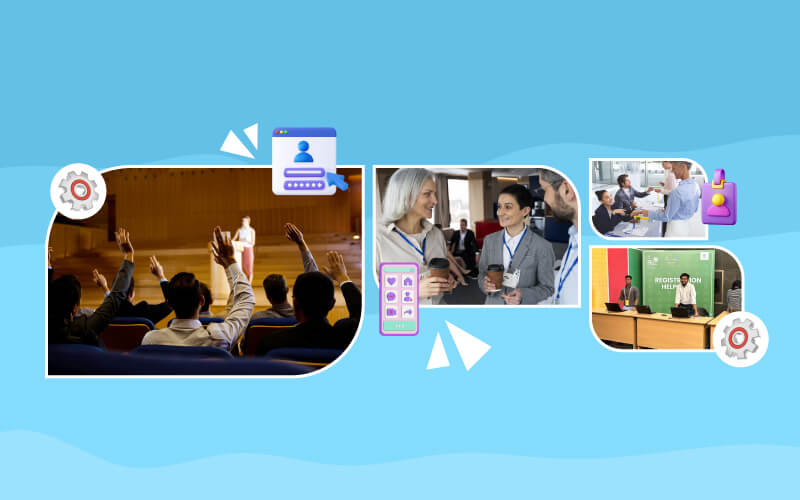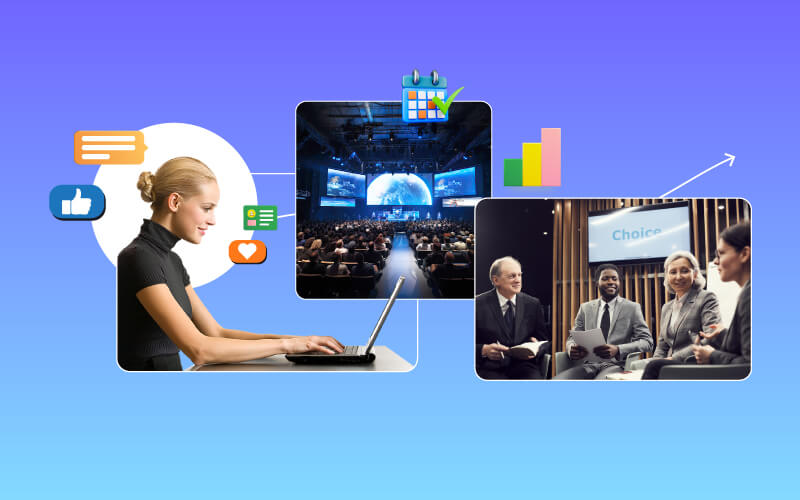The sudden transition to digital events has revolutionized the format of medical conferences. Healthcare sectors have leveraged virtual events for collaboration where healthcare professionals can come together to share research and new medical advancements even in unprecedented times. To ensure a successful online healthcare conference, you must have the right technology, planning, and engaging content.
In 2025, virtual medical conferences will offer several advantages, including cost efficiency, global accessibility, and interactive engagement opportunities. Whether you want to choose the right platform or need to increase attendee engagement, this guide has it all to help you organize a seamlessly effective healthcare conference.
Table of Contents
Virtual Medical Conferences 101: Understanding the Concept
A virtual healthcare conference is an online meeting for healthcare professionals, researchers, and industry leaders to network and collaborate on healthcare innovations and advancements. Similar to medical conferences, which have gone virtual, these occur on digital platforms where live streaming, panel discussions, and networking spaces are all available.

What are the Benefits of Virtual Medical Conferences?
There are many benefits associated with a virtual medical conference which is why they are increasingly gaining traction.
Wide Accessibility: A web-based healthcare event does away with travel limitations, enabling worldwide involvement in the event.
Economical: Conducting medical meetings online helps to minimize traveling, housing, and venue expenses. Virtual conferences also minimize carbon footprints by reducing travel needs, aligning with sustainability goals in the healthcare sector
Sustainability: Digital events lower the carbon footprint of physical events.
Measurable Success with Data-Driven Insights: Organizers of virtual healthcare conferences have access to analytics for tracking the success of their events.
Types of Medical Conferences
Virtual Medical Conferences: Web-based with live and recorded presentations.
Hybrid Healthcare Conferences: A combination of both physical attendance and remote participation through using technology.
On-Demand Medical Conferences: Pre-recorded meeting sessions are available to attendees after the event is over.
The 9-Step Roadmap to Hosting a Seamless Virtual Medical Conference
We know that planning for a virtual healthcare conference is a meticulous process. So make sure you follow these steps to succeed:
Step 1: Identify Your Goals
But first, you need to know why you are hosting a medical conference: knowledge sharing, networking, industry discussion, etc.
Define KPIs that you can measure to see if your healthcare conference was a success.
Determine the key takeaways for attendees—what insights, skills, or connections should they gain by the end of the conference?
Step 2: Identify Your Target Audience
What is your primary audience for the medical conference- physicians, researchers, medical students?

Design the content for healthcare conferences according to the requirements and expectations of the attendees.
Step 3: Select the Virtual Event Platform
Select a platform that allows live streaming, audience and participant interaction, and even live Q&A, breakout rooms, and special sessions for a successful medical conference.
This is a healthcare conference that will address sensitive issues concerning human health, so security and compliance are key.
Ensure the platform supports integrations with medical software, EHR systems, and compliance tools to maintain data security and enhance the attendee experience.
Step 4: Create a Captivating Content Plan
Fun ideas for your medical conference, such as keynote or Panel, Interactive Case Study
It is all the more valuable through video content, real medical cases, and discussions with AI.
Use live quizzes, interactive polls, and gamified challenges to make your medical conference more engaging. Reward active participation with incentives like certificates or exclusive content.
Offer multiple content tracks based on attendee interests (e.g., research innovations, clinical practices, healthcare technology).
Step 5: Secure High-Profile Speakers
Have top medical professionals speak at your medical conference to draw a quality crowd at the event.
Train and tech support speakers before the healthcare conference to ensure a seamless session.
Step 6: Create a Conference Marketing Strategy
Leverage LinkedIn, email marketing, and targeted social media ads to increase attendance for your conference.

Seek partnerships with medical associations and industry influencers for maximum outreach for your healthcare conference.
Step 7: Provide an Easy Registration Process
A user-friendly registration platform for your medical conference.
Provide multi-tier access to varying degrees of involvement in the health care symposium.
Simplify the signup process by allowing attendees to register using social media logins or pre-filled forms, reducing friction and increasing conversions.
Ensure flexibility by supporting various payment methods, including credit cards, PayPal, and even offline options, to accommodate a global audience.
Step 8: Organize Rehearsals & Technical checks
The last thing anyone wants is for technical difficulties to spoil a great symposium.
Ensure that an IT support team is at the healthcare conference during the entire event.
Step 9: Make, Modify, and Measure Performance
Send out post-event surveys or conduct follow-up interviews to understand attendee experiences and identify areas for improvement in your next healthcare conference.
The post-event analysis will enable you to measure the success of your healthcare conference and plan improvements for the future.
Evaluate session attendance, participation in Q&As, and networking activity to assess which segments of the virtual medical conference were the most impactful.
Crafting a High-Impact Virtual Conference Content Strategy
Building confidence in the audience without them being aware is the key to an engaging medical conference, This can be done by writing a well-engaged content strategy.

Essential Elements of a Powerful Content Strategy:
Offer techniques: Get insurance policy services to have roundtable discussions as well as Q&A and keynotes.
Interactive Sessions: Bring an interactive element to your medical conference using real-life medical case studies, hands-on demonstrations, and more.
Combine With Multimedia: Use videos, 3D simulators, and VR experiences to add value to your healthcare conference.
Content Delivery Best Practices:
Keep the sessions short (30-45 Minutes) to retain the attention of the audience.
Enable delegates to access archived sessions on-demand for additional healthcare conference involvement.
Building a Digital Stage: Selecting the Right Tech & Tools
A good virtual event platform is critical to the success of your medical conference and providing your attendees with a seamless, engaging experience. A robust solution offers optimized communication, better networking, and analytical insights powered by data. So, what should you look out for in the right technology for your healthcare conference? Here are the must-have features:
Live Streaming & Recording Features
A must-feature in the case of engaging keynote speakers, panel discussions, or expert sessions in a medical conference. This enables attendees to also tune in live or catch recorded occurrences afterward to make sure that critical insights are not missed by anyone in attendance. Multi-stream functionalities allow you to hold multiple sessions concurrently for different topics of your healthcare conference.
Networking Tools
Ai-powered matchmaking tools assist attendees in connecting with like-minded professionals who are interested in similar disciplines. A medical conference can be made interactive with additional features like virtual breakout rooms, one-on-one video meetings, and real-time chat. Also, Scientific updates are a major motivation for attending both in-person and virtual conferences (81.3% and 85.4%, respectively). By establishing a thriving networking environment, you secure the initiation of collaborative opportunities and create chances for forming impactful professional connections within your healthcare conference.
Virtual Exhibitor Booths
Digital booths are used by sponsors, healthcare organizations, and medical companies to display their newest research, products, and services. Brochures can be explored alongside demo videos and live Q&A sessions with representatives. Virtual booths generate sponsorship revenue and create value for the medical conference by providing participants with real-time interactions with experts in their field.

Audience Engagement Features
Ensure the platform offers interactive components like live polls, Q&As, gamification, and surveys. These tools ensure that attendees actively participate with you and make your healthcare conference interactive. Gamification elements including leaderboards and rewards can be additional incentives that enhance engagement and encourage attendance throughout sessions.
Custom Branding & Personalization
Customize the platform with your medical conference branding, providing a professional and cohesive experience. More immersive experiences: Platforms that offer event spaces, attendee dashboards, and registration pages tailored to a specific organization’s brand.
Virtual Conference KPIs
Key Performance Indicators (KPIs) to Measure:
Registration vs. Attendance Rate: Tracks participant engagement in the healthcare conference.
Session Duration & Drop-off Rate: Measures audience retention in the medical conference.
Post-Event Surveys: Gather feedback to improve future healthcare conferences.
Future-Proofing Virtual Medical Conferences: Trends & Innovations
With advancements in technology, virtual medical conferences will be more immersive, interactive, and efficient. To modernize your healthcare conference in 2023, it’s important to embrace innovation and new trends.
Emerging Technologies in Virtual Healthcare Conferences
AI-Powered Networking: AI-driven matchmaking tools improve attendee interactions at medical conferences, streamlining networking by recommending relevant professionals based on common interests and expertise.
Virtual Reality (VR) Demonstrations: Participants can immerse themselves in hands-on learning at a healthcare conference through VR that provides interaction with medical simulations, surgical procedures, and interactive case studies.
Augmented Reality (AR) Presentations: AR combines digital information with real-world visuals to provide a more interactive experience in medical training and product demonstrations at medical conferences.
Blockchain for Data Security: Data exchanged at Healthcare Conferences is protected by blockchain technology that ensures secure and transparent sharing between two channels.
Voice & Chatbot Assistants: AI-based virtual assistants can assist participants in moving through sessions, resolving FAQs, and providing real-time assistance during a medical conference.
How to Stay Ahead in Virtual Medical Conferences
Adopt new event tech continuously: Make sure your medical conferences are equipped with the latest event management software that has the most innovative features.
Customize Attendee Experiences: AI-powered recommendations offer personalization in areas such as content, networking, and session suggestions, ensuring that healthcare conferences are more relevant and engaging to every attendee.
Increased Audience Interaction: Implement real-time polling, interactive Q&A sessions, and gamification to increase engagement at medical conferences.
Invest in Hybrid Event Features: Future-proof your healthcare conference by ensuring you invest in hybrid event features that enable the seamless interaction of your virtual and in-person attendees.
Mobile Accessibility: Make sure your medical conference platform is mobile-friendly so attendees can join sessions, network, and access content from whatever device they choose.
Conclusion
A virtual healthcare conference in 2025 requires a lot of preparation, and you will need to get everything right, including the platform, format, and content. Incorporating the latest technology, ensuring data security, and putting emphasis on attendee engagement is key to executing a successful medical conference. Medical conferences will keep evolving, with increased accessibility and innovation, due to the popularity of digital events. Their integration will make your healthcare conference relevant and beneficial.
FAQs
Hosting a virtual medical conference comes with challenges such as ensuring high engagement, selecting the right technology, maintaining data security, and managing time zone differences for global attendees. To overcome these, organizers should leverage interactive tools like live Q&As, networking sessions, and AI-powered matchmaking while ensuring compliance with healthcare regulations.
To keep attendees engaged, incorporate interactive elements like real-time polling, breakout sessions, gamification, and networking lounges. Using multimedia formats such as VR demonstrations, live surgeries, and AI-driven discussions can also enhance participant involvement and knowledge retention.
Sponsors and exhibitors can use virtual booths, branded content, and targeted lead-generation tools to maximize their ROI. Features like live demos, downloadable brochures, AI-powered matchmaking, and sponsored sessions help exhibitors engage with the right audience and build meaningful connections.
An ideal virtual event platform should offer live streaming, audience engagement tools, AI-powered networking, virtual exhibitor booths, analytics tracking, and mobile compatibility. Additionally, integrations with electronic health records (EHR) systems, compliance tools, and real-time technical support are essential for a seamless experience.





















